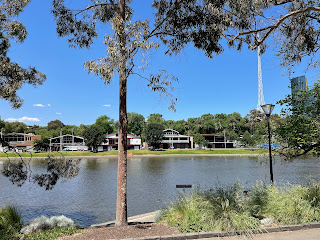This morning our tour leader, Callum "Blinky" Pyper, took us on a walking tour of the city. We actually duplicated some of the same locations that we had found on our own yesterday, but we had better commentary. On the other hand, a group moves much more slowly.
The first lesson was that, if you wish to speak Australian, the name of this city spelled, "Melbourne" is pronounced here as "MEL-bin." Americans tend to draw out the vowels much more than the natives.
From the station just a block from our hotel we rode the tram three stops in the same direction we had traveled toward Chinatown to eat last evening. We got off near the Royal Arcade. We would know an "arcade" as a shopping mall in the U.S. This one is historic, having opened in 1870. It's only a block long and looks very much its age, but it's considered a very prestigious retail location, nevertheless.
Unfortunately, due to the "Race Day" holiday for the running of the Melbourne Cup horse race, most of the businesses in the Royal Arcade and on the surrounding streets were closed. The good thing was that there were hardly any people on the usually crowded and bustling sidewalks ("footpaths" in Aussie).
And those people we did see (other than tourists like us) were decked out in their finest Race Day attire: suits or even morning coats for men (usually with a yellow rose boutonniere), and very fancy dresses for women, with high heels and "fascinator" hats. We weren't sure if these folks were actually going to the track, or just attending Race Day parties.
Among the buildings of architectural significance in the area were the old central post office (now an H&M store), and somewhat later, the Flinders Street Station, opened in 1854 and still the second-busiest railway hub in Australia.
In between, Blinky took us on various back streets and narrow alleys, called "laneways," that are lined with tiny cafes and bars, but too narrow for vehicles. The route finished with the Hosier Lane, which we had found on our own yesterday as the location of street art covering every reachable surface.
Our walk continued through Federation Square, and then down to the north bank of the Yarra River. We learned that the river got its name from early explorers who asked the indigenous people of the area what they called the waterway. But not speaking English, the natives replied, "yarra," which the English only later discovered means, "What? We don't know what you're saying," in the local dialect.
After an included lunch at a restaurant on Federation Square, we had the afternoon free to explore on our own. Mary and I went back to Flinders Street Station and caught the #35 tourist tram, which takes a circle tour around the circumference of the entire "C.B.D." or Central Business District.
The tram is free, but was packed to standing room only and hotter than blazes, especially near the window on the north side where Mary sat with the spring sun beaming in. The conductor seemed to love his job, and was offering to take photos of all the tourists aboard.
We got off at Parliament Station which, as one might expect, is right in front of Parliament House where the legislature of the State of Victoria meets. Constructed in 1855, it was the seat of the Parliament of Australia from 1901 until 1927, when Melbourne was the temporary capital of the nation.
Of course, Parliament House was closed for Race Day, so we went across the street to the Imperial Pub, a rather posh establishment with beer prices to match, and sat among the crowd that had gathered with eyes glued to the TV screens to watch the Melbourne Cup horse race. They say that this is "the race that stops a nation," and sure enough, the crowd got very quiet when the horses were off.
We're told that some pubs can get pretty raucous near the end of the race, because gambling is the Australian national sport, and nearly every citizen of the country has money riding on a horse. We did not see a reaction of that magnitude here. It may have been too sophisticated a crowd.
We shared a table at the pub with a retired American who now lives permanently in Vietnam, and who was as much a curious Race Day tourist as we were. It was an interesting conversation about his travels and his decision to live out his retirement as an expatriate.
After finishing our beer, we took a brief walk in the Treasury Gardens, a large park adjacent to the Parliament grounds. We had plans to continue into the even larger Fitzroy Gardens, but the heat and the long day on our feet began to catch up to us. We took a regular tram back into the city and toward our hotel. It was just as hot and crowded as the tourist tram had been, but at least neither of us was sitting in the sun.
Our Welcome Dinner was at Young & Jackson, a very famous Melbourne restaurant near Flinders Street Station. One of the features that makes Young & Jackson so well known is Chloe's Bar -- named after an 1875 oil painting by French artist Jules Joseph Lefebvre depicting the character in "Mnasyle et Chloé," a poem by the 18th-century Frenchman André Chénier.
Young & Jackson will not be as famous for its food, which was just OK -- except for the giant chocolate brownie dessert.











No comments:
Post a Comment